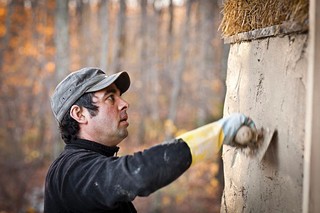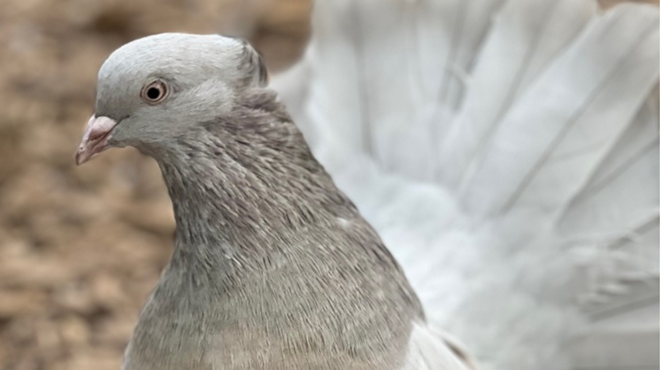Labor intensive but otherwise inexpensive at about $7 per bale for local dry straw, compressed and bound with nylon, contemporary straw-bale construction is experiencing a popularity surge in the Hudson Valley. “There is a tradition of handmade homes in the Hudson Valley, and straw bale lends itself really well to the sophisticated, sculptural aesthetic today’s green homeowners desire,” says William Johnson, owner of Will III, Inc., the construction company that built the Gomes-McGinniss home. Johnson is currently building another straw- bale home in Woodstock.
Johnson (pictured above applying stucco to the straw bales on the Gomes-McGinnis home) says that while few people are initiating construction right now, most who do are aware of the long-term energy savings, structural longevity, and maintenance-free attributes of straw bale. “People hire us to build special homes, so we encourage straw bale,” says Johnson. “Not only is it the most environmentally friendly and least toxic choice, but these homes can also last hundreds of years. We advise clients to be brave and go for it.”
Built on the plains of Africa since just after the last ice age, straw-bale structures over 400 years old still stand in parts of Europe.
A standard straw bale measures approximately 36” x 18” x 14”. Most larger farms in the area have mechanical hay balers, necessary for making firm “building blocks.”
Straw-bale house walls are formed by driving long oak stakes through the middle of the bales. The stakes are fastened with spikes to the timber frame. Sometimes straw bale is covered with wood siding instead of stucco for aesthetic reasons.
Three types of stucco may be used for straw-bale construction: clay, cement, and lime. Lime is the most expensive, but it’s strong, flexible, and breathes, so it’s more durable. Cement can crack and require extra fuel to produce. Clay is cheap but softens under wet conditions.
Hydraulic lime, which is preferred, costs about $40 for a 60-pound bag; 200 bags were needed to coat the Gomes-McGinniss home with three coats of stucco. Hydraulic lime has naturally occurring traces of clay and other minerals, and unlike 100 percent pure lime, it will actually set up under water. The base stucco layer is called the scratch coat; the second layer is known as the brown coat; and the final layer is the finish coat. The curing time between the first and second layers is a minimum of three days, but three weeks is advised. Johnson buys hydraulic lime from Pennsylvania-based LimeWorks.us, a company known for its historic preservation work.
“In every performance category, I would put a properly built straw-bale home in a test against a conventionally framed building with fiberglass insulation,” says Johnson.
- Home
- Arts
- Food & Drink
- Towns
- Home & Design
-
Towns
- Accord
- Amenia
- Beacon
- The Berkshires
- Catskill
- Chatham
- Cold Spring
- Cornwall
- Ellenville
- Gardiner
- Garrison
- Germantown
- Goshen
- Great Barrington
- Hunter
- High Falls
- Highland
- Hillsdale
- Hopewell Junction
- Hudson
- Hyde Park
- Kerhonkson
- Kinderhook
- Kingston
- Marlboro
- Middletown
- Millbrook
- Millerton
- Montgomery
- Mount Tremper
- New Paltz
- New Windsor
- Newburgh
- Orange County
- Pawling
- Peekskill
- Phoenicia
- Poughkeepsie
- Putnam County
- Red Hook
- Rhinebeck
- Rosendale
- Saugerties
- Stone Ridge
- Sugar Loaf
- Tivoli
- Wappingers Falls
- Warwick
- Woodstock
- Westchester
- Lifestyle
- Horoscopes
- Cannabis
- Wellness
- The River
- Events
- Chronogrammies
- Newsletters
- Add Your Event
- Support Us
- Login
- sign in
- Username
Support Chronogram
Related Content
Website
Chronogram













